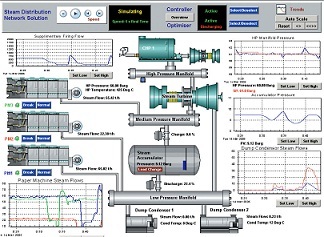- Home
- Industries
- Steam Distribution Network

Steam Distribution Network:
Stability, Load Balancing and Energy Efficiency
Case Study
Pulp and Paper - Steam Network
Company
Aylesford Newsprint Limited
Challenge
Improve load balancing, stability, efficiency
Solution
Steam Network Optimisation
Results
Payback within 3 months
BUSINESS CHALLENGE
Aylesford Newsprint Limited manufactured a range of 100% recycled newsprint under the "Renaissance" brand. The Aylesford site in the south-east of England operated two paper machines; PM13 and PM14 to produce an average of 400,000 tonnes of recycled newsprint every year.
A critical process in the Aylesford site is the steam distribution network. The overriding control task in the network is to balance steam generation with consumption and to respond to the large dynamic load changes which are imposed by the paper machines. Due to the variety of constraints imposed by the network and large dynamic load changes operation of the network using regulatory control can be extremely problematic.
The business challenge is deliver the correct quantities of steam to the machines while avoiding inefficient operation through excessive gas consumption, steam dumping or venting.to atmosphere. Read more...
PERCEPTIVE SOLUTION
 The main task of the steam network is to generate and deliver process steam for the paper machines. Operation of the industrial power plants differs markedly from that of typical condensing power plants with stable or slowly changing loads; the industrial power plants typically being exposed to large and fast load changes caused by breaks and tail-feeding of the paper machines. The dynamics of the load disturbances are often far beyond the control capability of the boilers regulating the steam delivery network. Thus different kinds of load leveling components and control loops are needed to stabilise the steam pressures in different headers during the rapid load changes in the steam network. These can be in the form of steam accumulators, let down stations and steam vents.
The main task of the steam network is to generate and deliver process steam for the paper machines. Operation of the industrial power plants differs markedly from that of typical condensing power plants with stable or slowly changing loads; the industrial power plants typically being exposed to large and fast load changes caused by breaks and tail-feeding of the paper machines. The dynamics of the load disturbances are often far beyond the control capability of the boilers regulating the steam delivery network. Thus different kinds of load leveling components and control loops are needed to stabilise the steam pressures in different headers during the rapid load changes in the steam network. These can be in the form of steam accumulators, let down stations and steam vents.
Perceptive Engineering's solution is to construct a robust model which describes the interactions between key stock flows, vacuums and retention chemicals, and their influence on backwater consistency and drainage. This model is used in a Model Predictive Controller to reduce wet-end and sheet variation by handling the machine interactions and dynamics. A real-time optimiser is coupled to the controller to ;maximise energy efficiency and ensure optimal use of the machine’s retention chemicals.
RETURN ON INVESTMENT
The project required less than 12 weeks to implement. Perceptive's controller reduced the standard deviation of white water consistency by at least 60%, depending on the grade being manufactured. Sheet ash variability was reduced by more than 50%, which enabled higher mean ash levels to be maintained and fibre costs to be reduced, without compromising sheet strength or printability.
Greater stabilisation of the wet end also enabled tighter control of sheet moisture. Combined with improved control of steam distribution and reduction in steam losses during breaks or starts, average steam consumption was reduced by 10%. Where drying capacity had been a process bottleneck, production rates could now be increased by almost 5%.
